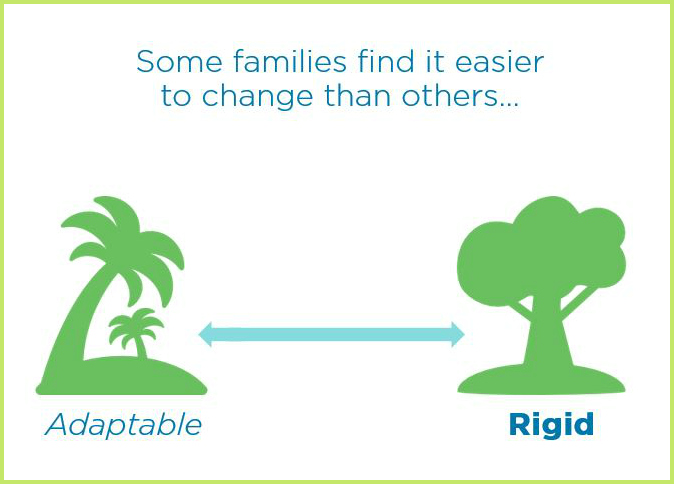A generation ago, the president of a manufacturing company reassigned his brother-in-law, a plant manager, to two distinct and distant locations within a two-year period. Soon thereafter, his facility was sold and the president offered his brother-in-law a position with considerably less responsibility — so much so, that the man retired early. While it happened 50 years ago, the man’s four children remember their uncle’s life-changing decisions vividly. Today their families harbor resentment and do not mix well with the rest of the larger family.
Whether transitioning to new business, changing governance leadership, managing the aftermath of a long-anticipated liquidity event, or moving from centralized family leadership to governance that includes more voices, business families must learn to anticipate and confidently handle change. Change management principles are not new, yet there are special considerations when applying them to a business family.
We think of change in a family enterprise as falling into two broad categories:
- Natural change, or that which is inevitable, such as the departure of senior-generation members and the rise of next-generation as owners and leaders
- Planned/intentional change, purposely initiated changes such as adding independent directors to the board or transitioning from family managing the business to owning it (nose in, fingers out)
In the sections below, we discuss both types of change along with providing a change management perspective, tactical advice, and examples for thoughtfully and effectively dealing with change in your family enterprise.
The Challenge of Change
Change involves both situational and psychological dimensions, or what can be thought of as external and internal aspects. The external components of change, which are easy to observe, may happen quickly, such as the installation of a new board of directors or the passing of an influential senior-generation member. However, the internal psychological dimensions are more subtle and take much longer to accept and adapt to, such as the negative feelings among family members who have reluctantly given up governance roles to new independent directors or mourning the loss of a family leader. So it’s critical to deal with change in both dimensions, especially the harder, more psychological ones.
Not surprisingly, some families adapt to change more easily, while others are more rigid and less accepting of change and more resistant to its implications. Take, for example, the arrival of a new spouse into the family. This event causes hardly a ripple in some families, but can be highly turbulent in others, regardless of the personality or intentions of the new family member.

While many families struggle with change, it can be even more challenging and complex in business families because of the interrelatedness of family, business and ownership. Change in any one of the three systems will inevitably result in shifts, often unexpected, in the other two.
The earlier example of the president changing his brother-in-law’s location in the business and the impact in the family a generation later points to the importance of understanding change in its full context, including anticipating and addressing resistance to change.
Understand Resistance to Address Resistance
Resistance can be seen as a natural reaction to any significant transition. William Bridges describes transition as involving three stages: an ending, a neutral zone, and a new beginning.1 Most people focus on the ending and new beginning, but not the middle, failing to understand the challenges of this neutral zone, where the past situation is in the rear-view mirror but the new one hasn’t yet taken hold. Most humans aren’t comfortable with ambiguity, so this middle zone can be a place of concern and confusion, leading naturally to resistance (though it can also be a period that facilitates creativity and innovation). Placing change in this context can help you understand and accept resistance on your part or that of others, and develop thoughtful, strategic tactics for addressing the challenge of change.
A change manager tries to understand resistance, learn from it and take active steps to address it. It’s not healthy, nor useful, to simply wish it away or label it as someone else’s problem. Resistance is usually an important source of information. Business owners resist adding independent directors for several reasons; a common one is because of a perceived loss of control. By understanding this source of resistance, more attention can be given to specific ways the owners can influence and benefit the business even if they don’t all hold positions on the board. Addressing resistance as a positive will lead to better transition management for the business family.
Tactics and Mechanisms for Addressing Change
Below are several tactics and mechanisms for addressing change effectively:
- Involvement: Get more of the family involved, listen to what they have to say and engage them in understanding and managing the change.
- Education: Provide education for all family members about the change in question and its purpose and broader context.
- Compelling purpose: Communicate the change in the context of the overall compelling purpose of the family and make it relevant for all individuals and groups affected before the change happens.
- Task force or pilot group: Create a small group of family members and others to lead the change, or pilot it within a smaller part of the organization before implementing it more widely.
- Champion model: Harness the abilities of an individual or group of family members who are passionate about a change.
- Parallel planning: Plan for both the business and family simultaneously with attention to understanding how change on one dimension affects the other.
- Skill development: Use the change as a motivation to gain new capabilities, whether related to management, governance, or other areas.
- Consultant: Retain an outside consultant to help formulate, communicate and implement challenging change.
- Trimming the tree: Create opportunities for family members to gracefully exit as owners if they do not want to be included in changes desired by the majority.
- Generation skipping: Shift the family unity and continuity focus of attention from the generation of the family members who have experienced long periods of unresolved conflict to their children and in so doing bypass a deadlock.
- Lay the groundwork: Put in place policies and fair practices early before they are needed so that unpopular family role changes in the business will be perceived as fair and not personal – as in the case of the President and his brother-in-law described above, the detailed performance evaluation of any individual working in the business cannot be made available to a spouse or his children, but the steps followed in a fair process can be fully communicated.
Let’s consider several of these tactics in the context of two examples drawn from real family business situations.
A New Board of Directors (planned change)
The Jensen family, owners of a large Midwestern manufacturing business, planned to bring on a new, more formal board of directors and used several interrelated tactics to ensure a smooth, collaborative process. Leaders recognized that family members, owners, and managers might be nervous about the change — such as questioning whether the new directors would represent the family well — and resistant to it.
To prepare, they used a series of meetings to help educate and involve the family regarding the upcoming change before it happened. Leaders representing the family (including a family champion), owners, and executives spoke about the compelling purpose of the family (continued unity as the family grows and becomes more complex) and helped the owners understand they could remove the board in part or whole in the future, if necessary.
The family worked with a consultant to create a task force of family members and non-family managers responsible for recruiting new board members, developing a system for selecting these members and evaluating their ongoing performance. Multiple family members got involved in the change, and the comprehensive preparation resulted in a more professional board from which the family benefited significantly.
Transition from Second to Third Generation (natural change)
The Rodriguez family faced a shift between generations as second-generation members approached the end of their roles as executives, directors, and owners of the family’s growing West Coast real estate business. In anticipation of the change, members of both the second and third generations had worked on parallel planning to develop a purpose and vision for the future of the business and family, developing clear roles and responsibilities to fill in the enterprise.
Rather than making changes overnight, third-generation members were moved into new business and governance roles with increasing involvement over time—along with guidance and mentorship from the earlier generation. The family also sought education about performance evaluation and compensation and developed a transparent, fair, merit-based system that encouraged third-generation members to excel as a team. The family worked with an outside consultant to help rising leaders understand their strengths and develop new skills to fulfill their business and governance roles.
Because of the family’s hard work, the second generation was able to let go more easily and the third generation felt supported in their new responsibilities, with ongoing mentorship and involvement from their predecessors.
Embrace Change
Change doesn’t always have to be a threat. It can be a positive opportunity to create understanding, trust, and capability. That doesn’t mean managing it will be easy; utilizing mutually reinforcing tactics requires thoughtfulness and planning.
In closing, consider the truths below when anticipating or while in the midst of changes in your family enterprise:
- First create understanding: People can’t — or don’t want to — change when they don’t understand the change.
- Expect resistance: Resistance is part of the change process. Work with it, not against it.
- Think internal and external: Understand and address the situational and psychological aspects of the change process to be successful.
- Patience is a virtue: Sustainable change requires purpose, planning, and patience. It won’t happen overnight.
- Be proactive: Manage change through effective planning and effective change tactics.
Taking all the ideas here to heart will help you manage — and benefit from — change even more effectively in your family enterprise.
[1]For more information on transitions and their stages, see William Bridges, Transitions: Making Sense of Life’s Changes, Da Capo Press, 2004.
Free Webinar Recording
Ready or Not, Here it Comes! How to Manage Change in Your Enterprising Family
Learn the valuable lessons from those who have well-managed changes such as: succession, transition to non-family leadership, engaging the family in family governance, formalizing business governance, and more. Presented by Wendy Sage-Hayward and Steve McClure. For more information or to view…

